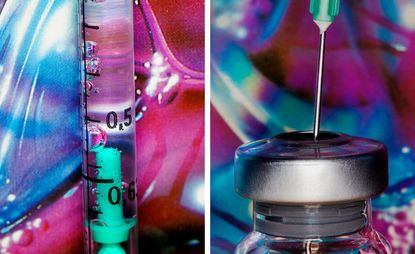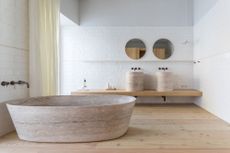Discover the secrets of London’s most high profile cosmetic dermatologist
How Dr Frances Prenna Jones has transformed cosmetic dermatology with her holistic approach
- (opens in new tab)
- (opens in new tab)
- (opens in new tab)
- Sign up to our newsletter Newsletter

Cosmetic dermatologist Dr Frances Prenna Jones calls the waiting room of her office in London’s Mayfair her ‘disco room’. There are glitter balls on display, alongside an incongruous collection of other items including department store-style vanity tables and a Fritz Hansen chair, all of it bathed in an ambient neon yellow light.
It seems odd at first – especially considering that the room is regularly visited by some of the city’s most famous faces – but it soon becomes clear that this relaxed, jovial space is a reflection of the Dr Jones philosophy. ‘Everybody wants to feel seen and everybody wants to feel well,’ she says.
Cosmetic dermatology as self-care
‘I wanted to create an environment where people don’t feel guilty or intimidated. I want people to come into this space and think it is perfectly OK, in fact, a good thing, to take care of themselves.’ Since opening her practice, Jones has pioneered cosmetic dermatology as a form of ‘self-care’ rather than ‘self-improvement’, combining non-invasive cosmetic treatments with machine therapies and her own skincare formulations. With a menu that runs the gamut from Botox injections and fillers to infrared light treatments, peels and skin rejuvenation facials, she has a singular talent for steadily and delicately altering the face without a hint of artificial intervention.
‘You arrive at the clinic convinced that you need a bit of Botox here or a little filler there,’ says one of her patients. ‘What you actually need is a professional, the best in the business, to identify your areas of concern and explain exactly how you can treat them. It’s not about turning back the clock, it’s about making an enhanced, better version of yourself. It’s a self-confidence boost to beat all others.’ According to Jones, her work is its own kind of anthropology: her high-profile client list reflects the zeitgeist, and each client reveals unique insights from their life when they walk through the door.

One of the biggest changes she has noticed recently is a significant increase in male patients. ‘When I first started doing this, I had a lot of male patients, then the male-to-female [ratio] dwindled a little bit and in the past three years, the number has started to rise again. I think it goes back to self-care. During the pandemic, a lot of men spent more time at home, seeing their spouses or partners take care of themselves and thinking they would do the same. More than 50 per cent of the men that have come in have a partner who is already a patient of mine.’ Jones has also seen an uptick in women between the ages of 35 and 55 who would not have considered getting any kind of treatment pre-Covid. Her guess is that the pandemic encouraged them, like her new male clients, to spend more of their disposable income on themselves.
Of course, all of this is liable to change. ‘It will be interesting to see what happens in the next couple of years when people can travel again and do other things,’ says Jones. ‘One of my patients owns a really big London gallery. She assumed they would have to close their offices when the pandemic hit, but then, within two weeks, they had already had one of their best years ever, because people were at home staring at blank walls, and had disposable income that they used to spend on other things. In the same way, the pandemic gave people the same [time and residual income] to think about spending money on themselves. I get that art is appreciable, and investing in yourself is a different return on investment, but there is evidence to support the [significant] mental and physical returns when you feel good about yourself.’
A small-batch product line
As Jones’ story shows, cosmetic dermatology is a union of the scientific and the aesthetic. She worked as an NHS cardiologist for ten years before discovering her interest in cosmetic surgery. She then helped launch UK pharmacy Boots’ in-store laser clinics before establishing her own practice. In the midst of it all, she was satisfying her creative yearnings, studying fashion design at Central Saint Martins and developing her own product line.
These products, which Jones has personally overseen, from the formulation down to the packaging, are perhaps one of the best-kept secrets in beauty. Produced in small batches in Devon, they are practically youth in a jar. Her toner-exfoliator-serum, Formula, which boosts cell renewal and removes impurities, inspired such a dedicated following that, near Christmas in 2006, a businessman from New York diverted his trip to London on a mission to bring some back home for his wife, knocked on the door of her clinic, held out a small cut-out picture of the product, and begged her to find him a bottle.

‘That’s when I knew we had created a monster,’ says Jones, who has the alert energy you would expect from someone who expertly juggles so many balls – seemingly helped, on the day of our interview, by the contents of an enormous coffee mug filled with apple cider vinegar, dark maple syrup, lemon juice and water, which she substitutes for caffeine. Asked if there are any industry myths she wants to debunk, Jones answers, ‘Let me get my soapbox out and climb on.’
Dr Frances Prenna Jones on Botox, fillers and skincare
First on the agenda is the notion that anything with chemicals is harmful. ‘First of all, water is a chemical. The world is one big chemical, so stop saying chemicals [are a bad thing].
‘Secondly, stop going on about organic essential oils – some of the most irritating products for your skin are essential oils, which can cause eczema, contact dermatitis, hypersensitivity, and more. Thirdly, you do need preservatives, because without a preservative you have bacteria growing in your product that will grow on your face.’
Another bone of contention for Jones is the idea that Botox is a toxin and, if you use it, you will inevitably look like your face has been frozen. Before the Covid vaccine, she says, Botox was the most commonly given drug in the world. ‘When you simply extrapolate the efficacy of the drug by these sheer numbers, the idea that it is dangerous is wrong.’
As for fillers, Jones prefers to call them ‘volume replacement’ to emphasise that they are not actually filling up the face like a balloon, but replacing fat loss that naturally occurs as you age. Jones believes machines are misused and stresses the importance of educating yourself about what is available before choosing a treatment.
A holistic approach
‘There are a lot of unsupervised beauty therapists who are either using machines sub-optimally, or are using them in isolation. It is much more beneficial to use them in a holistic fashion, as one tool in your anti-ageing armoury, whether that is to treat sun damage, reduce fine lines, or improve collagen, elastin, and the rest of it.’ Machines are an essential part of Jones’ practice, but if she could choose only one, it would be her Intense Pulsed Light machine, nicknamed ‘Betty’, which uses a combination of light wavelengths to destroy age spots, rosacea and other unwanted discolourations.
Yet for all the machines out there, the fact is that effective skincare requires a multi-pronged approach. ‘It comes down to what you are putting on your skin, what treatments you are doing, your diet and your psychology,’ summarises Jones, who believes a holistic approach, rather than a one-time fix, can truly impact how you look and feel.
INFORMATION
A version of this article appears in the October 2022 issue of Wallpaper*, available in print, on the Wallpaper* app on Apple iOS, and to subscribers of Apple News +. Subscribe to Wallpaper* today!
drfrancesprennajones.com (opens in new tab)
Mary Cleary is the Beauty & Grooming Editor of Wallpaper*. Having been with the brand since 2017, she became an editor in February 2020 with the launch of the brand’s new beauty & grooming channel. Her work seeks to offer a new perspective on beauty, focusing on the pioneering personalities, product designs, and transformative trends within the industry.
-
 Remembering New York artist Daniel Brush, 1947 – 2022
Remembering New York artist Daniel Brush, 1947 – 2022In tribute to Daniel Brush, who has died aged 75, we revisit this 2020 Wallpaper* profile of the elusive New York artist by jewellery historian Vivienne Becker, who unravelled the secrets of his singular designs for her book, ‘Daniel Brush: Jewels Sculpture’
By Vivienne Becker • Published
-
 Interior design books championing shelf love
Interior design books championing shelf loveWelcome to the Wallpaper* guide of the best interior design books published in 2022 and beyond – a collection of riveting visual tomes to feed creative innovation, inspiration and imagination
By Rosa Bertoli • Published
-
 Christmas decorations from leading creatives and design brands
Christmas decorations from leading creatives and design brandsOur edit of contemporary Christmas decorations ranges from architect-designed festive ornaments to Christmas baubles by leading creatives
By Rosa Bertoli • Published
-
 Beauty spots: indulge at these standout New York salons
Beauty spots: indulge at these standout New York salonsWe select the best New York salons, offering expert beauty treatments for hair, nails, face, wellness and more in distinctively designed spaces
By Tilly Macalister-Smith • Last updated
-
 Skate park design goes to the British seaside with Guy Hollaway’s F51
Skate park design goes to the British seaside with Guy Hollaway’s F51F51 is Folkestone's brand new, dedicated, multistorey skate park, courtesy of the Roger De Haan Charitable Trust and Hollaway Studio
By Ellie Stathaki • Last updated
-
 Through the lens of Wallpaper* contributor Benjamin Vigliotta
Through the lens of Wallpaper* contributor Benjamin Vigliotta‘Through the lens’ is our monthly series that throws the spotlight on emerging photographers who are Wallpaper* contributors. Here we explore their vision further.
By Ellie Stathaki • Last updated
-
 Testing the water at Copenhagen's 1960s modernist swimming baths
Testing the water at Copenhagen's 1960s modernist swimming bathsHere, we revist our feature from the July 2012 issue of Wallpaper* (W*159), when we explored a refreshingly-designed Copenhagen public bathing complex
By Emma O'Kelly • Last updated
-
 BIG’s ‘Gople’ lamp wins Wallpaper* Design Award for Life-Enhancer of the Year
BIG’s ‘Gople’ lamp wins Wallpaper* Design Award for Life-Enhancer of the YearBy Mary Cleary • Last updated
-
 Tom Dixon creates spa at Greenwich Peninsula in London
Tom Dixon creates spa at Greenwich Peninsula in LondonBy Ellie Stathaki • Last updated
-
 Italian sportswear giant Fila looks backwards to go forwards
Italian sportswear giant Fila looks backwards to go forwardsBy Lou Stoppard • Last updated
-
 Linger for longer in these 10 design-led luxury hotel bathrooms
Linger for longer in these 10 design-led luxury hotel bathroomsThe pleasure of bathing has never been so passionately pursued, with hotels throwing themselves wholeheartedly into the creation of spaces that are less amenity and more amusement. No longer a side thought, the best of these new personal pleasure palaces, often clad in enough marble to make an Emperor sigh, range from onsen minimalism to technological trickery. Take a look at the hotel bathrooms that have us lingering for longer.
By Warren Singh-Bartlett • Last updated










